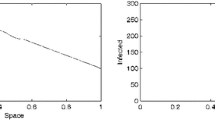Abstract
It was reported that there are traveling patterns in the spatiotemporal data of epidemics (Cummings et al., Nature 427:344, 2004; Grenfell et al., Nature 414:716, 2001). To well understand the mechanism, we present a spatial epidemic model with migration, which means that the individuals exhibit a correlated motion toward certain direction, and obtain traveling pattern. Our results may be helpful to understand the mechanism of the spatiotemporal epidemics and have potential application of control of the epidemics.
Similar content being viewed by others
References
Cummings, D.A., Irizarry, R.A., Huang, N.E., Endy, T.P., Nisalak, A., Ungchusak, K., Burke, D.S.: Travelling waves in the occurrence of dengue haemorrhagic fever in Thailand. Nature 427, 344–347 (2004)
Filipe, J.A.N., Maule, M.M.: Effects of dispersal mechanisms on the spatiotemporal development of epidemics. J. Theor. Biol. 226, 125–141 (2004)
Ostfeld, R.S., Glass, G.E., Keesing, F.: Spatial epidemiology: an emerging (or re-emerging) discipline. Trends Ecol. Evol. 20, 328–336 (2005)
Hassell, M.P., Comins, H.N., May, R.M.: Species coexistence and self-organizing spatial dynamics. Nature 370, 290–292 (1994)
Kerr, B., Riley, M.A., Feldman, M.W., Bohannan, B.J.M.: Local dispersal promotes biodiversity in a real-life game of rock-paper-scissors. Nature 418, 171–174 (2002)
Eshel, I.: On the neighbor effect and the evolution of altruistic traits. Theor. Popul. Biol. 3, 258–277 (1972)
Morris, D.W., Diffendorfer, J.E., Lundberg, P.: Dispersal among habitats varying in fitness: source–sink dynamics, balanced dispersal or pulsed migration through ideal habitat selection? Oikos 107, 559–575 (2004)
Bascompte, J., Sole, R.V.: Spatially induced bifurcations in single-species population dynamics. J. Anim. Ecol. 159, 469–480 (1992)
Hanski, I.: Coexistence of competitors in patchy environment. Ecology 64, 493–500 (1983)
Hastings, A.: Spatial heterogeneity and ecological models. Ecology 71, 426–428 (1990)
Mollison, D.: Spatial contact models for ecological and epidemic spread. J. R. Stat. Soc. B 39, 283–326 (1977)
Courchamp, F., Pontier, D., Langlais, M., Artois, M.: Population dynamics of feline immunodeficiency virus within cat populations. J. Theor. Biol. 175, 553–560 (1995)
Haraguchi, Y., Sasaki, A.: Evolution of parasite virulence and transmission rate in a spatially structured population. J. Theor. Biol. 203, 85–96 (2000)
Hilker, F.M., Langlais, M., Petrovskii, S.V., Malchow, H.: A diffusive SI model with Allee effect and application to FIV. Math. Biosci. 206, 61–80 (2007)
Petrovskii, S., Morozov, A., Li, B.L.: Regimes of biological invasion in a predator–prey system with the Allee effect. Bull. Math. Biol. 67, 637–661 (2005)
Leppnen, T.: Ph.D. Thesis, Helsinki University of Technology, Finland (2004)
Medvinsky, A.B., Petrovskii, S.V., Tikhonova, I.A., Malchow, H., Li, B.-L.: Spatiotemporal complexity of plankton and fish dynamics in simple model ecosystems. SIAM Rev. 44, 311–370 (2002)
Petrovskii, S., Li, B.L., Malchow, H.: Transition to spatiotemporal chaos can resolve the paradox of enrichment. Ecol. Complex. 1, 37–47 (2004)
Sherratt, J.A., Lambin, X., Sherratt, T.N.: The effects of the size and shape of landscape features on the formation of traveling waves in cyclic populations. Am. Nat. 162, 503–513 (2003)
Bär, M., Or-Guil, M.: Alternative scenarios of spiral breakup in a reaction–diffusion model with excitable and oscillatory dynamics. Phys. Rev. Lett. 82, 1160–1163 (1999)
Xie, F., Xie, D., Weiss, J.N.: Inwardly rotating spiral wave breakup in oscillatory reaction–diffusion media. Phys. Rev. E 74, 026107 (2006)
Murray, J.D.: Mathematical Biology II: Spatial Models and Biomedical Applications. Springer, New York (2003)
Sherratt, J.A., Lambin, X., Thomas, C.J., Sherratt, T.N.: Generation of periodic waves by landscape features in cyclic predator–prey systems. Proc. R. Soc. Lond. B 269, 327–334 (2002)
Bjørnstad, O.N., Bascompte, J.: Synchrony and second order spatial correlation in host–parasitoid systems. J. Anim. Ecol. 70, 924–933 (2001)
Bjørnstad, O.N., Finkenstädt, B.F., Grenfell, B.T.: Dynamics of measles epidemics: estimating scaling of transmission rates using a time series SIR model. Ecol. Monogr. 72, 169–184 (2002)
Bolker, B.M., Grenfell, B.T.: Chaos and biological complexity in measles dynamics. Proc. R. Soc. Lond. B 251, 75–81 (1993)
Earn, D.J.D., Rohani, P., Bolker, B.M., Grenfell, B.T.: A simple model for complex dynamical transitions in epidemics. Science 287, 667–670 (2000)
Finkenstadt, B.F., Keeling, M.J., Grenfell, B.T.: Patterns of density dependence in measles dynamics. Proc. R. Soc. Lond. B 265, 753–762 (1998)
Rohani, P., Earn, D.J.D., Grenfell, B.T.: Opposite patterns of synchrony in sympatric disease metapopulations. Science 286, 968–971 (1999)
Grenfell, B.T., Bjornstad, O.N., Kappey, J.: Travelling waves and spatial hierarchies in measles epidemics. Nature 414, 716–723 (2001)
Author information
Authors and Affiliations
Corresponding author
Rights and permissions
About this article
Cite this article
Cui, M., Ma, TH. & Li, XE. Spatial behavior of an epidemic model with migration. Nonlinear Dyn 64, 331–338 (2011). https://doi.org/10.1007/s11071-010-9864-6
Received:
Accepted:
Published:
Issue Date:
DOI: https://doi.org/10.1007/s11071-010-9864-6




